
The Holy Roman Empire, also known as the Holy Roman Empire of the German Nation after 1512, was a polity in Central and Western Europe, usually headed by the Holy Roman Emperor. It developed in the Early Middle Ages and lasted for almost 1,000 years until its dissolution in 1806 during the Napoleonic Wars.

Pope Urban III, born Uberto Crivelli, reigned from 25 November 1185 to his death in 1187.

The 12th century is the period from 1101 to 1200 in accordance with the Julian calendar. In the history of European culture, this period is considered part of the High Middle Ages and overlaps with what is often called the "'Golden Age' of the Cistercians". The Golden Age of Islam experienced significant development, particularly in Islamic Spain.

Year 1086 (MLXXXVI) was a common year starting on Thursday of the Julian calendar.
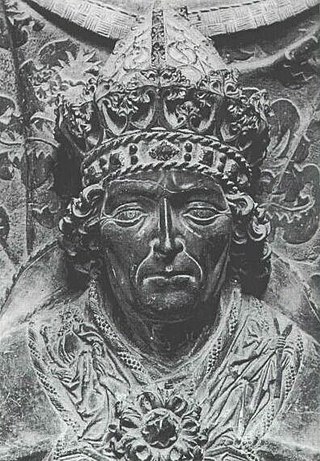
Louis IV, called the Bavarian, was King of the Romans from 1314, King of Italy from 1327, and Holy Roman Emperor from 1328 until his death in 1347.
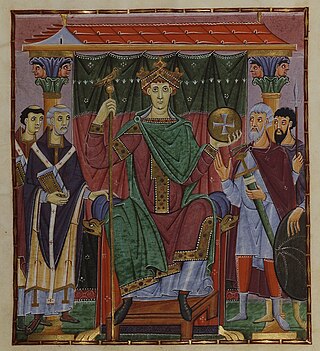
Otto III was the Holy Roman Emperor from 996 until his death in 1002. A member of the Ottonian dynasty, Otto III was the only son of the Emperor Otto II and his wife Theophanu.

The Holy Roman Emperor, originally and officially the Emperor of the Romans during the Middle Ages, and also known as the Roman-German Emperor since the early modern period, was the ruler and head of state of the Holy Roman Empire. The title was held in conjunction with the title of king of Italy from the 8th to the 16th century, and, almost without interruption, with the title of king of Germany throughout the 12th to 18th centuries.

The Papal States, officially the State of the Church, were a conglomeration of territories on the Apennine Peninsula under the direct sovereign rule of the Pope from 756 until 1870. They were among the major states of Italy from the 8th century until the Unification of Italy, between 1859 and 1870.
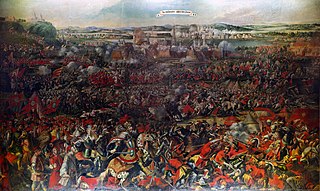
The Battle of Vienna took place at Kahlenberg Mountain near Vienna on 12 September 1683 after the city had been besieged by the Ottoman Empire for two months. The battle was fought by the Holy Roman Empire and the Polish–Lithuanian Commonwealth, both under the command of King John III Sobieski, against the Ottomans and their vassal and tributary states. The battle marked the first time the Commonwealth and the Holy Roman Empire had cooperated militarily against the Ottomans. The defeat is often seen as a turning point for Ottoman expansion into Europe, after which they would gain no further ground. In the ensuing war that lasted until 1699, the Ottomans would cede most of Ottoman Hungary to Leopold I, Holy Roman Emperor.
In ancient Rome, imperium was a form of authority held by a citizen to control a military or governmental entity. It is distinct from auctoritas and potestas, different and generally inferior types of power in the Roman Republic and Empire. One's imperium could be over a specific military unit, or it could be over a province or territory. Individuals given such power were referred to as curule magistrates or promagistrates. These included the curule aedile, the praetor, the consul, the magister equitum, and the dictator. In a general sense, imperium was the scope of someone's power, and could include anything, such as public office, commerce, political influence, or wealth.

The Investiture Controversy or Investiture Contest was a conflict between the Church and the state in medieval Europe over the ability to choose and install bishops (investiture) and abbots of monasteries and the pope himself. A series of popes in the 11th and 12th centuries undercut the power of the Holy Roman Emperor and other European monarchies, and the controversy led to nearly 50 years of conflict.

The Guelphs and Ghibellines were factions supporting respectively the Pope and the Holy Roman Emperor in the Italian city-states of Central Italy and Northern Italy during the Middle Ages.

The Schmalkaldic War was the short period of violence from 1546 until 1547 between the forces of Emperor Charles V of the Holy Roman Empire, commanded by the Duke of Alba and the Duke of Saxony, and the Lutheran Schmalkaldic League within the domains of the Holy Roman Empire.
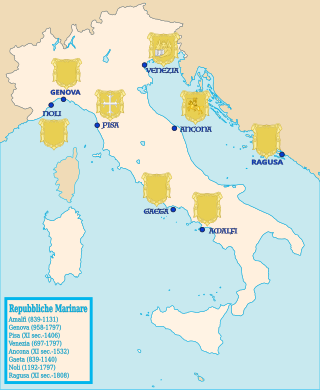
The history of Italy in the Middle Ages can be roughly defined as the time between the collapse of the Western Roman Empire and the Italian Renaissance. Late Antiquity in Italy lingered on into the 7th century under the Ostrogothic Kingdom and the Byzantine Empire under the Justinian dynasty, the Byzantine Papacy until the mid 8th century. The "Middle Ages" proper begin as the Byzantine Empire was weakening under the pressure of the Muslim conquests, and most of the Exarchate of Ravenna finally fell under Lombard rule in 751. From this period, former states that were part of the Exarchate and were not conquered by the Lombard Kingdom, such as the Duchy of Naples, became de facto independent states, having less and less interference from the Eastern Roman Empire.

The Commune of Rome was established in 1144 by Arnold of Brescia after a rebellion led with Giordano Pierleoni. Pierleoni led a people's revolt due to the increasing powers of the Pope and the entrenched powers of the nobility. The goal of the rebellion was to organize the government of Rome in a similar fashion to that of the previous Roman Republic. Pierleoni was named the "first Patrician of the Roman Commune", but was deposed in 1145.
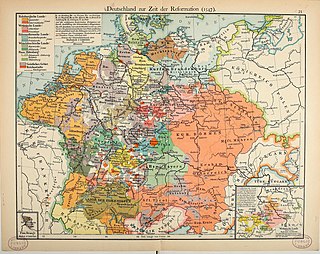
The Augsburg Interim was an imperial decree ordered on 15 May 1548 at the 1548 Diet of Augsburg by Charles V, Holy Roman Emperor, who had just defeated the forces of the Protestant Schmalkaldic League in the Schmalkaldic War of 1546/47. Although it ordered Protestants to readopt traditional Catholic beliefs and practices, including the seven Sacraments, it allowed for Protestant clergymen the right to marry and for the laity to receive communion in both kinds. It is considered the first significant step in the process leading to the political and religious legitimization of Protestantism as a valid alternative Christian creed to Roman Catholicism finally realized in the 1552 Peace of Passau and the 1555 Peace of Augsburg. The Interim became Imperial law on 30 June 1548. The Pope advised all bishops to abide by the concessions made to the Protestants in the Interim in August 1549.

The Battle of Monte Porzio was fought on 29 May 1167 between the Holy Roman Empire and the Commune of Rome. The communal Roman army, which one historian has called the "greatest army which Rome had sent into the field in centuries", was defeated by the forces of the Emperor Frederick Barbarossa and his local allies, the Counts of Tusculum and the ruler of Albano. Comparing its effect on the city of Rome, one historian has called Monte Porzio the "Cannae of the Middle Ages".

The Kingdom of Italy, also called Imperial Italy, was one of the constituent kingdoms of the Holy Roman Empire, along with the kingdoms of Germany, Bohemia, and Burgundy. It originally comprised large parts of northern and central Italy. Its original capital was Pavia until the 11th century.

Herman(n) of Salm, also known as Herman(n) of Luxembourg, the progenitor of the House of Salm, was Count of Salm and elected German anti-king from 1081 until his death.

The Saxon revolt was a civil war fought between 1077 and 1088, early in the history of the Holy Roman Empire. The revolt was led by a group of opportunistic German princes who elected as their figurehead the duke of Swabia, Rudolf of Rheinfeld, who became the anti-king. Rudolf was a two-way brother-in-law of the young King Henry IV of Germany, who had been crowned at the age of six and had taken the reins of power at age sixteen. The Great Revolt followed the Saxon Rebellion of 1073–75.

















